Management in a Global Environment: Culture, Strategy, and Holacracy
VerifiedAdded on 2020/03/04
|10
|1857
|131
Report
AI Summary
This report provides a comprehensive overview of management and organizations within a global environment, exploring various corporate cultures such as market, clan, adhocracy, and hierarchy. It examines the alignment of corporate culture with strategy and delves into the concept of Holacracy, comparing it with bureaucracy and team-based structures. The report analyzes contingency factors of organizational design, specifically focusing on Zappos's implementation of Holacracy. Furthermore, it discusses the role of innovative culture in fostering agile organizational structures. The analysis includes examples and case studies to illustrate key concepts, offering insights into leadership, strategic decision-making, and the adaptability of organizations in a dynamic global landscape. The report concludes with a summary of the key findings and their implications for effective management practices.
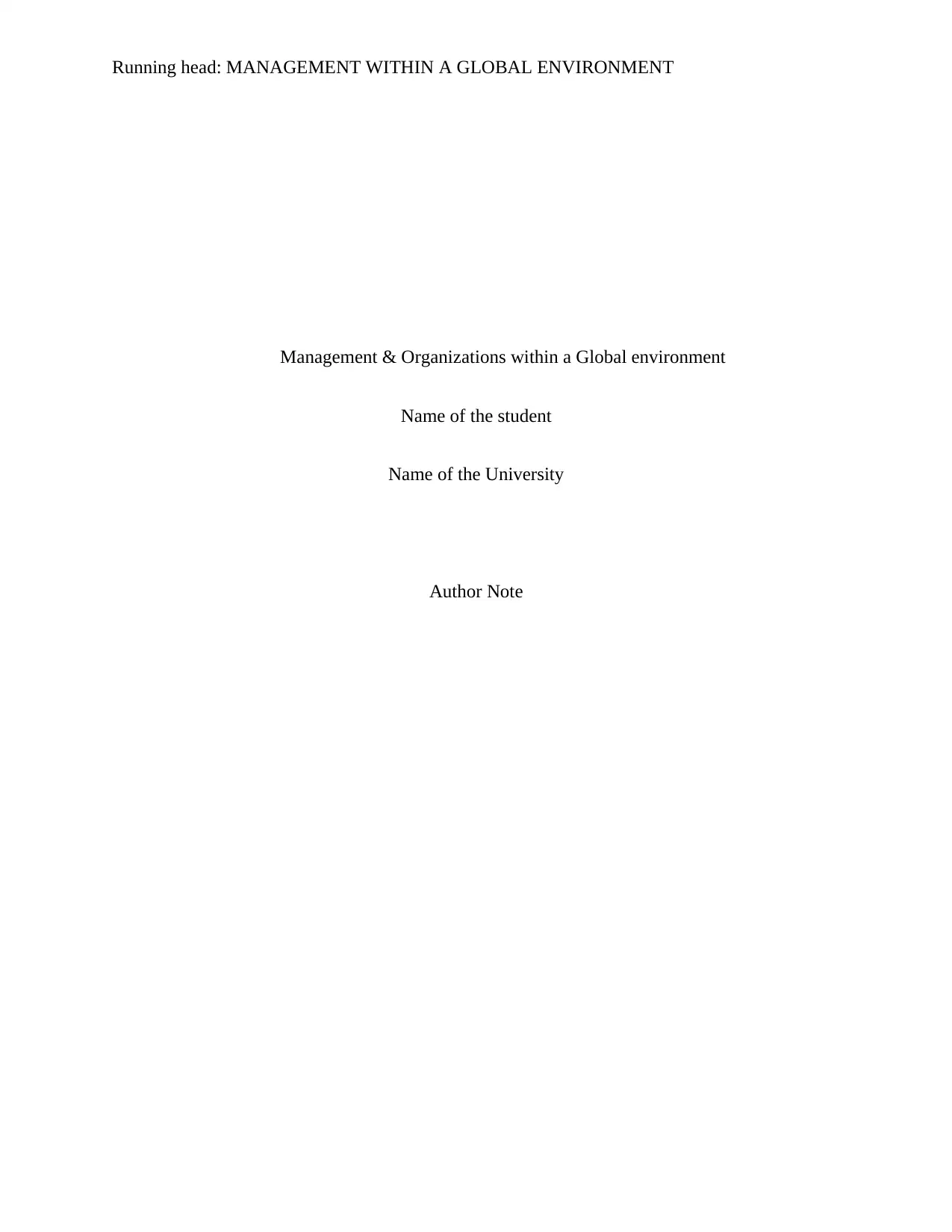
Running head: MANAGEMENT WITHIN A GLOBAL ENVIRONMENT
Management & Organizations within a Global environment
Name of the student
Name of the University
Author Note
Management & Organizations within a Global environment
Name of the student
Name of the University
Author Note
Paraphrase This Document
Need a fresh take? Get an instant paraphrase of this document with our AI Paraphraser
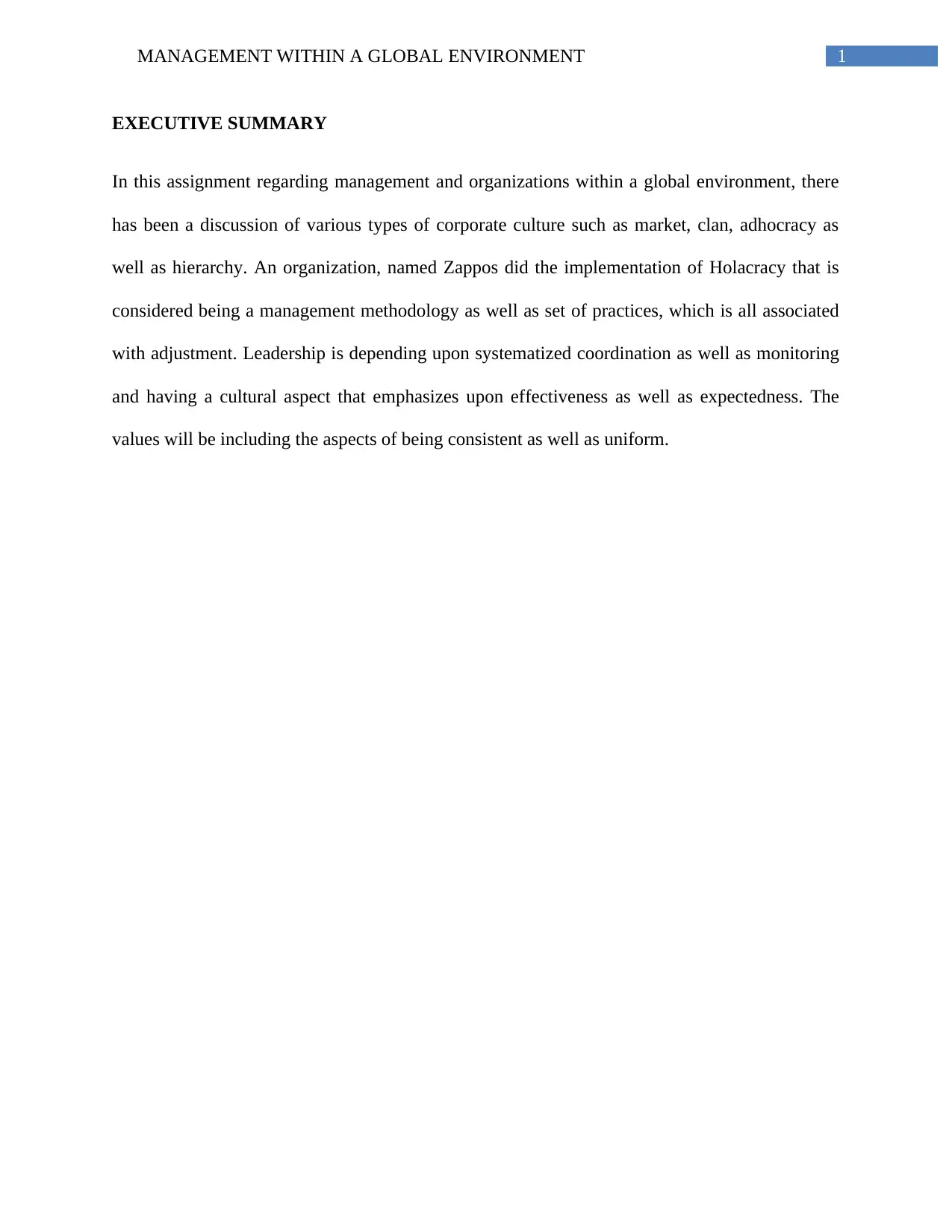
1MANAGEMENT WITHIN A GLOBAL ENVIRONMENT
EXECUTIVE SUMMARY
In this assignment regarding management and organizations within a global environment, there
has been a discussion of various types of corporate culture such as market, clan, adhocracy as
well as hierarchy. An organization, named Zappos did the implementation of Holacracy that is
considered being a management methodology as well as set of practices, which is all associated
with adjustment. Leadership is depending upon systematized coordination as well as monitoring
and having a cultural aspect that emphasizes upon effectiveness as well as expectedness. The
values will be including the aspects of being consistent as well as uniform.
EXECUTIVE SUMMARY
In this assignment regarding management and organizations within a global environment, there
has been a discussion of various types of corporate culture such as market, clan, adhocracy as
well as hierarchy. An organization, named Zappos did the implementation of Holacracy that is
considered being a management methodology as well as set of practices, which is all associated
with adjustment. Leadership is depending upon systematized coordination as well as monitoring
and having a cultural aspect that emphasizes upon effectiveness as well as expectedness. The
values will be including the aspects of being consistent as well as uniform.
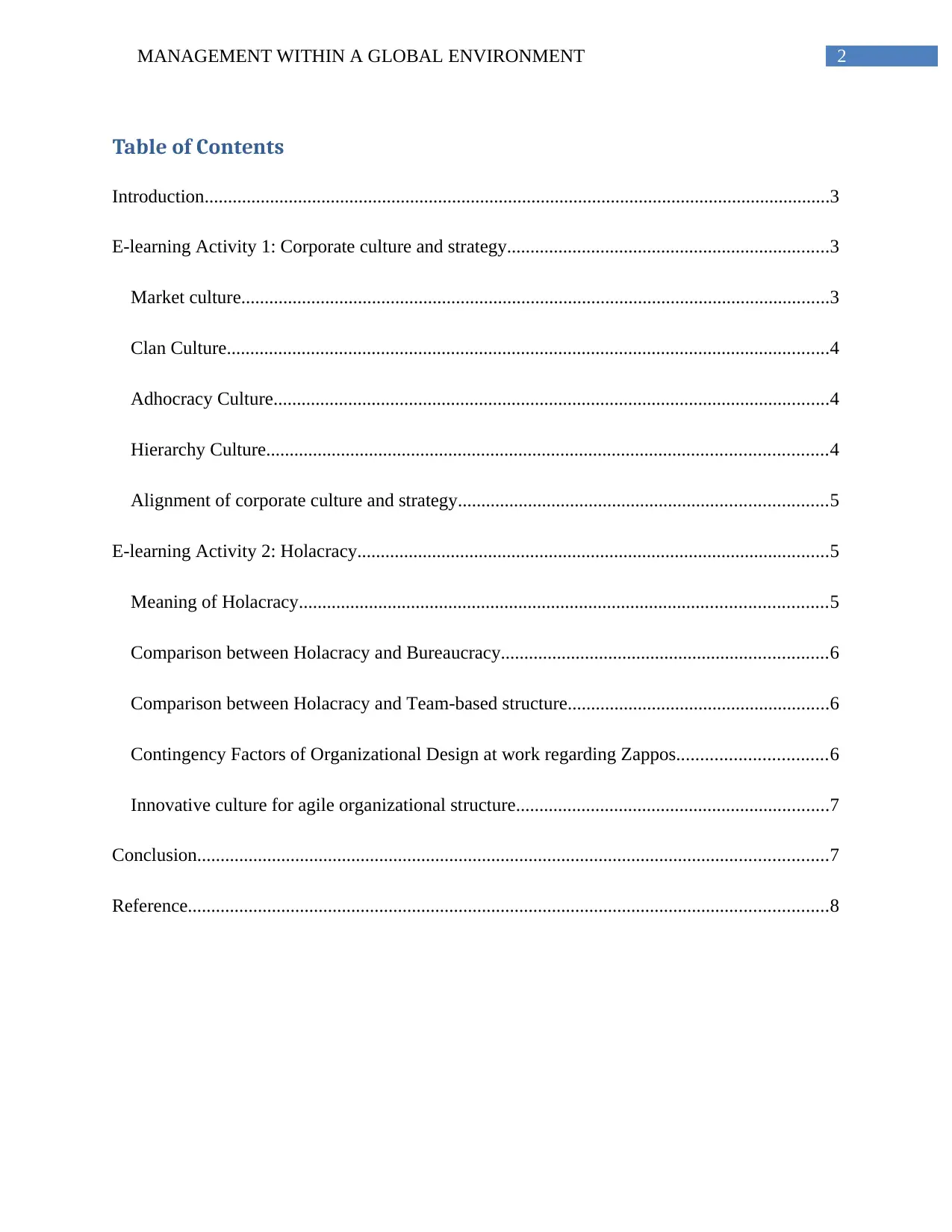
2MANAGEMENT WITHIN A GLOBAL ENVIRONMENT
Table of Contents
Introduction......................................................................................................................................3
E-learning Activity 1: Corporate culture and strategy.....................................................................3
Market culture..............................................................................................................................3
Clan Culture.................................................................................................................................4
Adhocracy Culture.......................................................................................................................4
Hierarchy Culture........................................................................................................................4
Alignment of corporate culture and strategy...............................................................................5
E-learning Activity 2: Holacracy.....................................................................................................5
Meaning of Holacracy.................................................................................................................5
Comparison between Holacracy and Bureaucracy......................................................................6
Comparison between Holacracy and Team-based structure........................................................6
Contingency Factors of Organizational Design at work regarding Zappos................................6
Innovative culture for agile organizational structure...................................................................7
Conclusion.......................................................................................................................................7
Reference.........................................................................................................................................8
Table of Contents
Introduction......................................................................................................................................3
E-learning Activity 1: Corporate culture and strategy.....................................................................3
Market culture..............................................................................................................................3
Clan Culture.................................................................................................................................4
Adhocracy Culture.......................................................................................................................4
Hierarchy Culture........................................................................................................................4
Alignment of corporate culture and strategy...............................................................................5
E-learning Activity 2: Holacracy.....................................................................................................5
Meaning of Holacracy.................................................................................................................5
Comparison between Holacracy and Bureaucracy......................................................................6
Comparison between Holacracy and Team-based structure........................................................6
Contingency Factors of Organizational Design at work regarding Zappos................................6
Innovative culture for agile organizational structure...................................................................7
Conclusion.......................................................................................................................................7
Reference.........................................................................................................................................8
⊘ This is a preview!⊘
Do you want full access?
Subscribe today to unlock all pages.

Trusted by 1+ million students worldwide
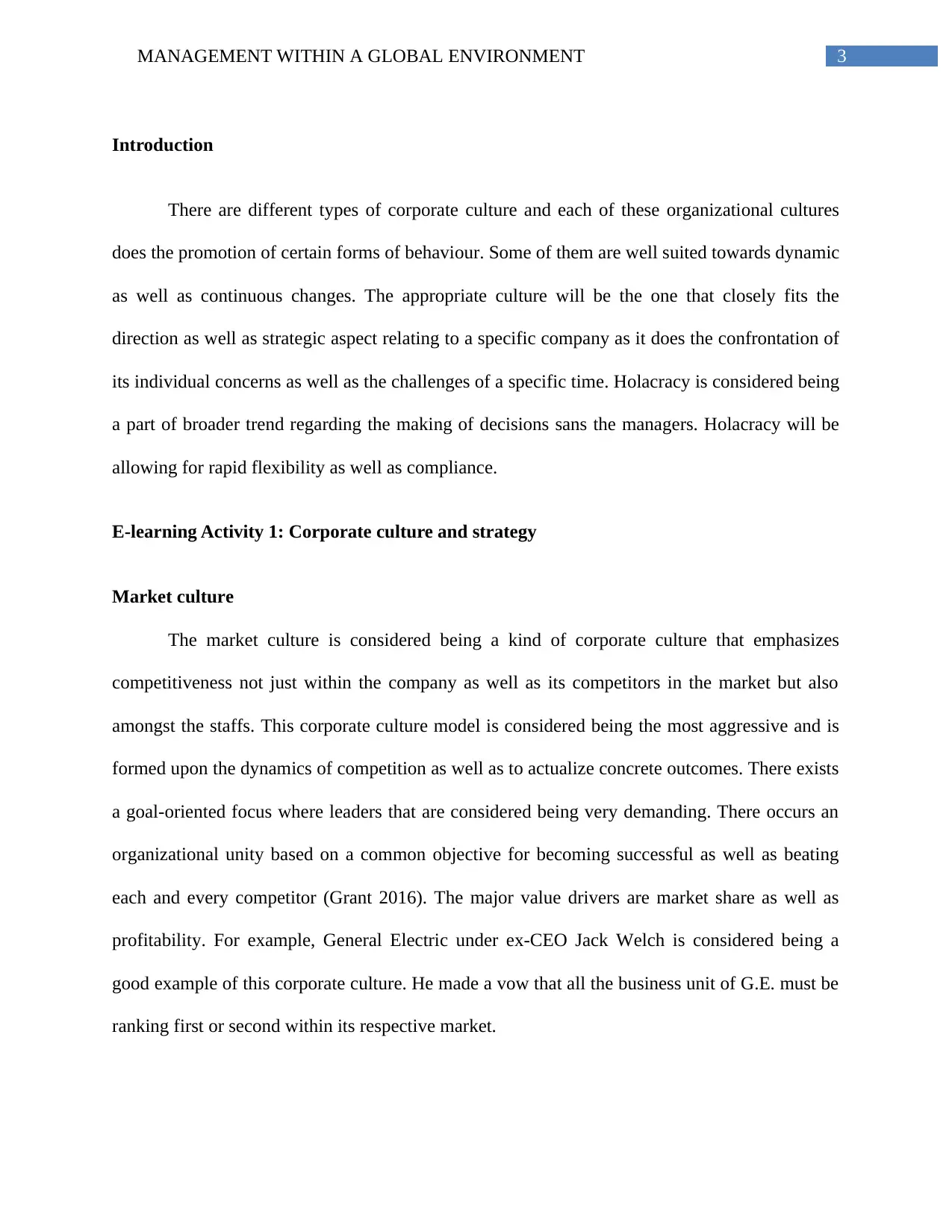
3MANAGEMENT WITHIN A GLOBAL ENVIRONMENT
Introduction
There are different types of corporate culture and each of these organizational cultures
does the promotion of certain forms of behaviour. Some of them are well suited towards dynamic
as well as continuous changes. The appropriate culture will be the one that closely fits the
direction as well as strategic aspect relating to a specific company as it does the confrontation of
its individual concerns as well as the challenges of a specific time. Holacracy is considered being
a part of broader trend regarding the making of decisions sans the managers. Holacracy will be
allowing for rapid flexibility as well as compliance.
E-learning Activity 1: Corporate culture and strategy
Market culture
The market culture is considered being a kind of corporate culture that emphasizes
competitiveness not just within the company as well as its competitors in the market but also
amongst the staffs. This corporate culture model is considered being the most aggressive and is
formed upon the dynamics of competition as well as to actualize concrete outcomes. There exists
a goal-oriented focus where leaders that are considered being very demanding. There occurs an
organizational unity based on a common objective for becoming successful as well as beating
each and every competitor (Grant 2016). The major value drivers are market share as well as
profitability. For example, General Electric under ex-CEO Jack Welch is considered being a
good example of this corporate culture. He made a vow that all the business unit of G.E. must be
ranking first or second within its respective market.
Introduction
There are different types of corporate culture and each of these organizational cultures
does the promotion of certain forms of behaviour. Some of them are well suited towards dynamic
as well as continuous changes. The appropriate culture will be the one that closely fits the
direction as well as strategic aspect relating to a specific company as it does the confrontation of
its individual concerns as well as the challenges of a specific time. Holacracy is considered being
a part of broader trend regarding the making of decisions sans the managers. Holacracy will be
allowing for rapid flexibility as well as compliance.
E-learning Activity 1: Corporate culture and strategy
Market culture
The market culture is considered being a kind of corporate culture that emphasizes
competitiveness not just within the company as well as its competitors in the market but also
amongst the staffs. This corporate culture model is considered being the most aggressive and is
formed upon the dynamics of competition as well as to actualize concrete outcomes. There exists
a goal-oriented focus where leaders that are considered being very demanding. There occurs an
organizational unity based on a common objective for becoming successful as well as beating
each and every competitor (Grant 2016). The major value drivers are market share as well as
profitability. For example, General Electric under ex-CEO Jack Welch is considered being a
good example of this corporate culture. He made a vow that all the business unit of G.E. must be
ranking first or second within its respective market.
Paraphrase This Document
Need a fresh take? Get an instant paraphrase of this document with our AI Paraphraser
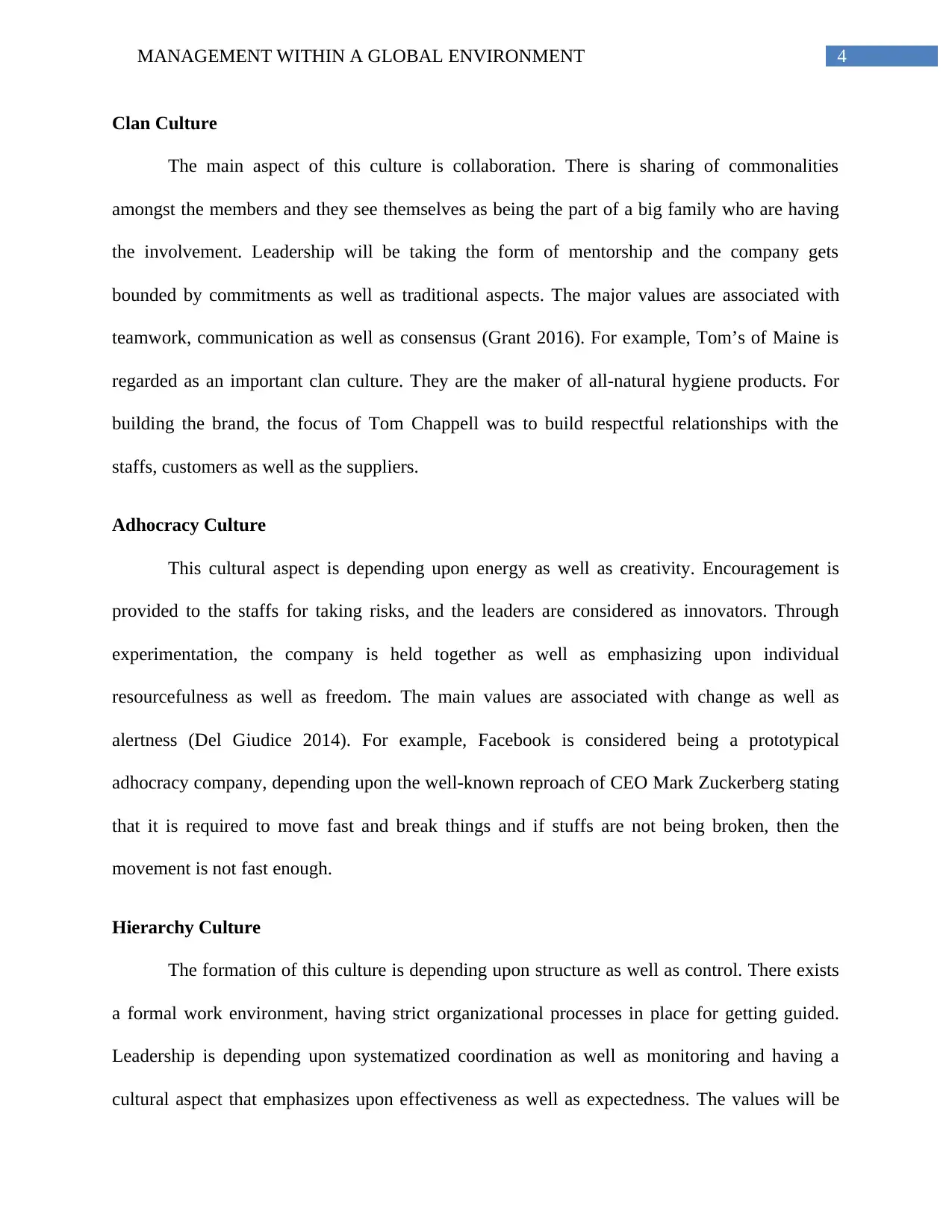
4MANAGEMENT WITHIN A GLOBAL ENVIRONMENT
Clan Culture
The main aspect of this culture is collaboration. There is sharing of commonalities
amongst the members and they see themselves as being the part of a big family who are having
the involvement. Leadership will be taking the form of mentorship and the company gets
bounded by commitments as well as traditional aspects. The major values are associated with
teamwork, communication as well as consensus (Grant 2016). For example, Tom’s of Maine is
regarded as an important clan culture. They are the maker of all-natural hygiene products. For
building the brand, the focus of Tom Chappell was to build respectful relationships with the
staffs, customers as well as the suppliers.
Adhocracy Culture
This cultural aspect is depending upon energy as well as creativity. Encouragement is
provided to the staffs for taking risks, and the leaders are considered as innovators. Through
experimentation, the company is held together as well as emphasizing upon individual
resourcefulness as well as freedom. The main values are associated with change as well as
alertness (Del Giudice 2014). For example, Facebook is considered being a prototypical
adhocracy company, depending upon the well-known reproach of CEO Mark Zuckerberg stating
that it is required to move fast and break things and if stuffs are not being broken, then the
movement is not fast enough.
Hierarchy Culture
The formation of this culture is depending upon structure as well as control. There exists
a formal work environment, having strict organizational processes in place for getting guided.
Leadership is depending upon systematized coordination as well as monitoring and having a
cultural aspect that emphasizes upon effectiveness as well as expectedness. The values will be
Clan Culture
The main aspect of this culture is collaboration. There is sharing of commonalities
amongst the members and they see themselves as being the part of a big family who are having
the involvement. Leadership will be taking the form of mentorship and the company gets
bounded by commitments as well as traditional aspects. The major values are associated with
teamwork, communication as well as consensus (Grant 2016). For example, Tom’s of Maine is
regarded as an important clan culture. They are the maker of all-natural hygiene products. For
building the brand, the focus of Tom Chappell was to build respectful relationships with the
staffs, customers as well as the suppliers.
Adhocracy Culture
This cultural aspect is depending upon energy as well as creativity. Encouragement is
provided to the staffs for taking risks, and the leaders are considered as innovators. Through
experimentation, the company is held together as well as emphasizing upon individual
resourcefulness as well as freedom. The main values are associated with change as well as
alertness (Del Giudice 2014). For example, Facebook is considered being a prototypical
adhocracy company, depending upon the well-known reproach of CEO Mark Zuckerberg stating
that it is required to move fast and break things and if stuffs are not being broken, then the
movement is not fast enough.
Hierarchy Culture
The formation of this culture is depending upon structure as well as control. There exists
a formal work environment, having strict organizational processes in place for getting guided.
Leadership is depending upon systematized coordination as well as monitoring and having a
cultural aspect that emphasizes upon effectiveness as well as expectedness. The values will be
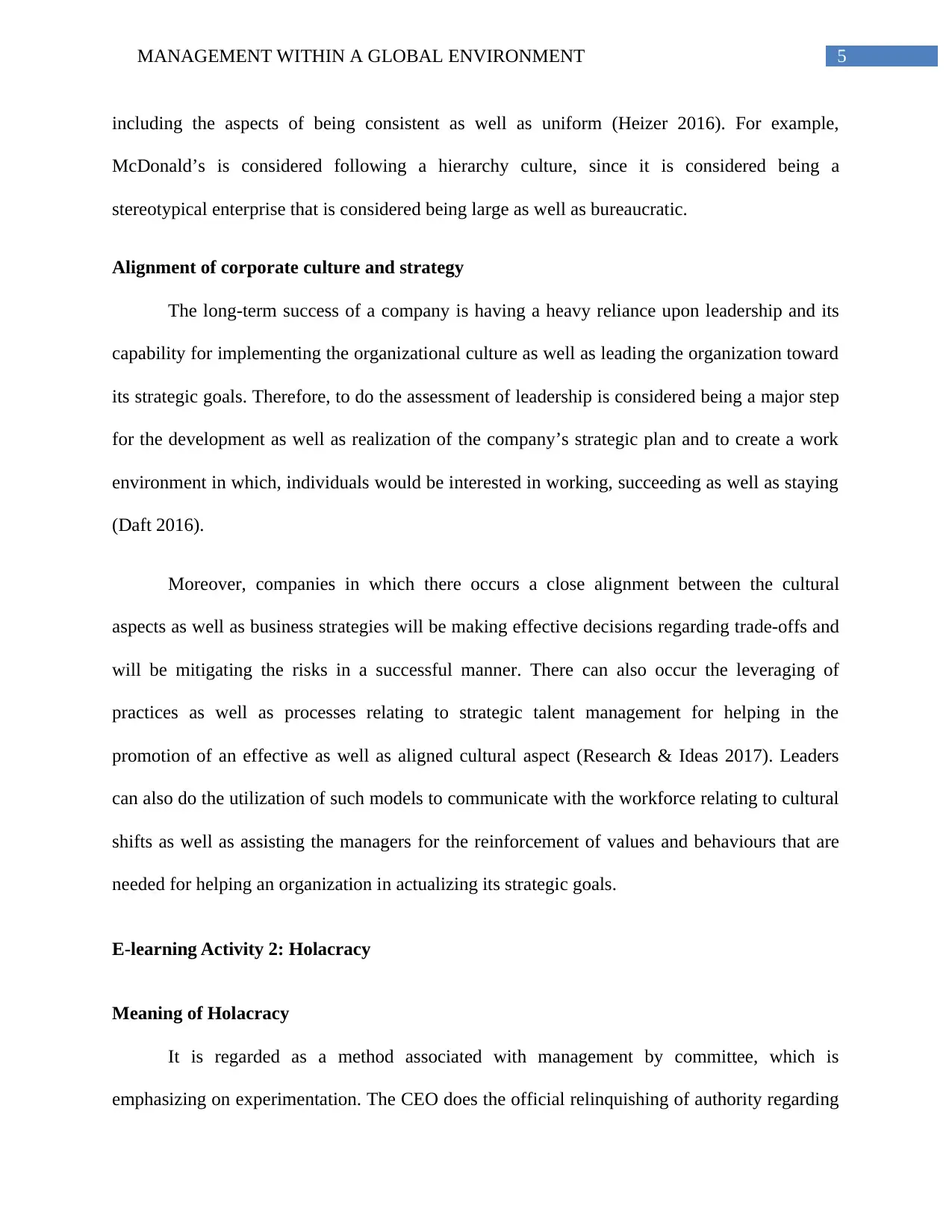
5MANAGEMENT WITHIN A GLOBAL ENVIRONMENT
including the aspects of being consistent as well as uniform (Heizer 2016). For example,
McDonald’s is considered following a hierarchy culture, since it is considered being a
stereotypical enterprise that is considered being large as well as bureaucratic.
Alignment of corporate culture and strategy
The long-term success of a company is having a heavy reliance upon leadership and its
capability for implementing the organizational culture as well as leading the organization toward
its strategic goals. Therefore, to do the assessment of leadership is considered being a major step
for the development as well as realization of the company’s strategic plan and to create a work
environment in which, individuals would be interested in working, succeeding as well as staying
(Daft 2016).
Moreover, companies in which there occurs a close alignment between the cultural
aspects as well as business strategies will be making effective decisions regarding trade-offs and
will be mitigating the risks in a successful manner. There can also occur the leveraging of
practices as well as processes relating to strategic talent management for helping in the
promotion of an effective as well as aligned cultural aspect (Research & Ideas 2017). Leaders
can also do the utilization of such models to communicate with the workforce relating to cultural
shifts as well as assisting the managers for the reinforcement of values and behaviours that are
needed for helping an organization in actualizing its strategic goals.
E-learning Activity 2: Holacracy
Meaning of Holacracy
It is regarded as a method associated with management by committee, which is
emphasizing on experimentation. The CEO does the official relinquishing of authority regarding
including the aspects of being consistent as well as uniform (Heizer 2016). For example,
McDonald’s is considered following a hierarchy culture, since it is considered being a
stereotypical enterprise that is considered being large as well as bureaucratic.
Alignment of corporate culture and strategy
The long-term success of a company is having a heavy reliance upon leadership and its
capability for implementing the organizational culture as well as leading the organization toward
its strategic goals. Therefore, to do the assessment of leadership is considered being a major step
for the development as well as realization of the company’s strategic plan and to create a work
environment in which, individuals would be interested in working, succeeding as well as staying
(Daft 2016).
Moreover, companies in which there occurs a close alignment between the cultural
aspects as well as business strategies will be making effective decisions regarding trade-offs and
will be mitigating the risks in a successful manner. There can also occur the leveraging of
practices as well as processes relating to strategic talent management for helping in the
promotion of an effective as well as aligned cultural aspect (Research & Ideas 2017). Leaders
can also do the utilization of such models to communicate with the workforce relating to cultural
shifts as well as assisting the managers for the reinforcement of values and behaviours that are
needed for helping an organization in actualizing its strategic goals.
E-learning Activity 2: Holacracy
Meaning of Holacracy
It is regarded as a method associated with management by committee, which is
emphasizing on experimentation. The CEO does the official relinquishing of authority regarding
⊘ This is a preview!⊘
Do you want full access?
Subscribe today to unlock all pages.

Trusted by 1+ million students worldwide
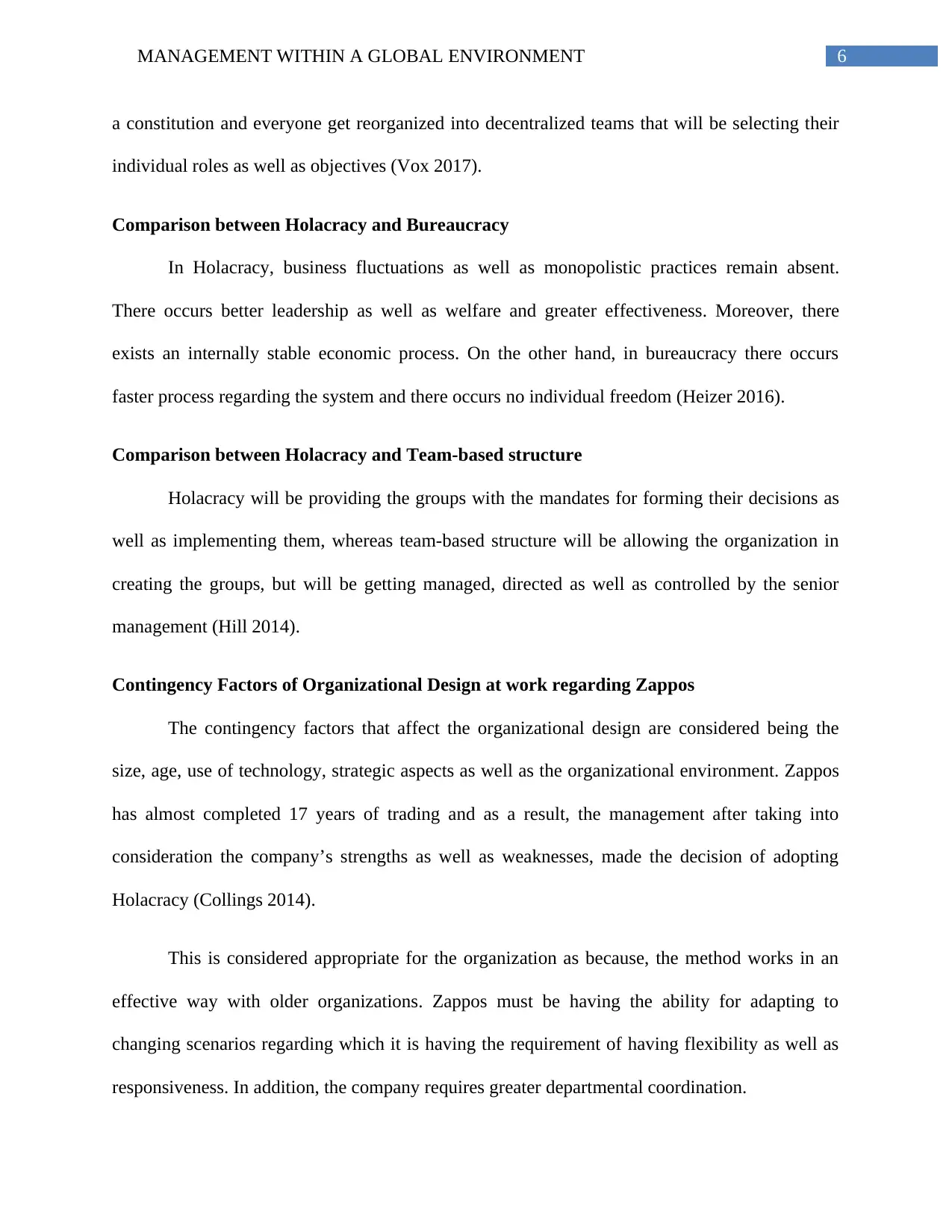
6MANAGEMENT WITHIN A GLOBAL ENVIRONMENT
a constitution and everyone get reorganized into decentralized teams that will be selecting their
individual roles as well as objectives (Vox 2017).
Comparison between Holacracy and Bureaucracy
In Holacracy, business fluctuations as well as monopolistic practices remain absent.
There occurs better leadership as well as welfare and greater effectiveness. Moreover, there
exists an internally stable economic process. On the other hand, in bureaucracy there occurs
faster process regarding the system and there occurs no individual freedom (Heizer 2016).
Comparison between Holacracy and Team-based structure
Holacracy will be providing the groups with the mandates for forming their decisions as
well as implementing them, whereas team-based structure will be allowing the organization in
creating the groups, but will be getting managed, directed as well as controlled by the senior
management (Hill 2014).
Contingency Factors of Organizational Design at work regarding Zappos
The contingency factors that affect the organizational design are considered being the
size, age, use of technology, strategic aspects as well as the organizational environment. Zappos
has almost completed 17 years of trading and as a result, the management after taking into
consideration the company’s strengths as well as weaknesses, made the decision of adopting
Holacracy (Collings 2014).
This is considered appropriate for the organization as because, the method works in an
effective way with older organizations. Zappos must be having the ability for adapting to
changing scenarios regarding which it is having the requirement of having flexibility as well as
responsiveness. In addition, the company requires greater departmental coordination.
a constitution and everyone get reorganized into decentralized teams that will be selecting their
individual roles as well as objectives (Vox 2017).
Comparison between Holacracy and Bureaucracy
In Holacracy, business fluctuations as well as monopolistic practices remain absent.
There occurs better leadership as well as welfare and greater effectiveness. Moreover, there
exists an internally stable economic process. On the other hand, in bureaucracy there occurs
faster process regarding the system and there occurs no individual freedom (Heizer 2016).
Comparison between Holacracy and Team-based structure
Holacracy will be providing the groups with the mandates for forming their decisions as
well as implementing them, whereas team-based structure will be allowing the organization in
creating the groups, but will be getting managed, directed as well as controlled by the senior
management (Hill 2014).
Contingency Factors of Organizational Design at work regarding Zappos
The contingency factors that affect the organizational design are considered being the
size, age, use of technology, strategic aspects as well as the organizational environment. Zappos
has almost completed 17 years of trading and as a result, the management after taking into
consideration the company’s strengths as well as weaknesses, made the decision of adopting
Holacracy (Collings 2014).
This is considered appropriate for the organization as because, the method works in an
effective way with older organizations. Zappos must be having the ability for adapting to
changing scenarios regarding which it is having the requirement of having flexibility as well as
responsiveness. In addition, the company requires greater departmental coordination.
Paraphrase This Document
Need a fresh take? Get an instant paraphrase of this document with our AI Paraphraser
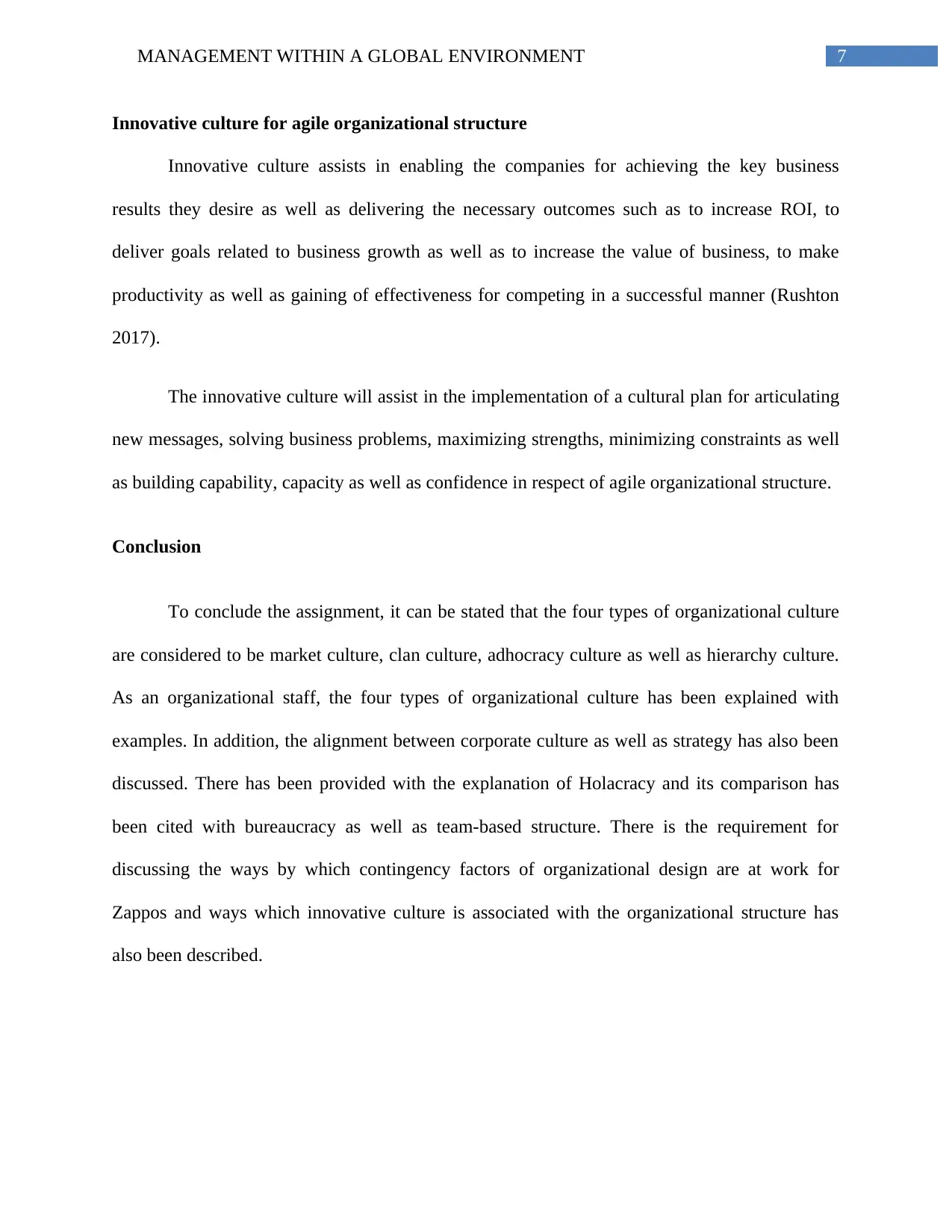
7MANAGEMENT WITHIN A GLOBAL ENVIRONMENT
Innovative culture for agile organizational structure
Innovative culture assists in enabling the companies for achieving the key business
results they desire as well as delivering the necessary outcomes such as to increase ROI, to
deliver goals related to business growth as well as to increase the value of business, to make
productivity as well as gaining of effectiveness for competing in a successful manner (Rushton
2017).
The innovative culture will assist in the implementation of a cultural plan for articulating
new messages, solving business problems, maximizing strengths, minimizing constraints as well
as building capability, capacity as well as confidence in respect of agile organizational structure.
Conclusion
To conclude the assignment, it can be stated that the four types of organizational culture
are considered to be market culture, clan culture, adhocracy culture as well as hierarchy culture.
As an organizational staff, the four types of organizational culture has been explained with
examples. In addition, the alignment between corporate culture as well as strategy has also been
discussed. There has been provided with the explanation of Holacracy and its comparison has
been cited with bureaucracy as well as team-based structure. There is the requirement for
discussing the ways by which contingency factors of organizational design are at work for
Zappos and ways which innovative culture is associated with the organizational structure has
also been described.
Innovative culture for agile organizational structure
Innovative culture assists in enabling the companies for achieving the key business
results they desire as well as delivering the necessary outcomes such as to increase ROI, to
deliver goals related to business growth as well as to increase the value of business, to make
productivity as well as gaining of effectiveness for competing in a successful manner (Rushton
2017).
The innovative culture will assist in the implementation of a cultural plan for articulating
new messages, solving business problems, maximizing strengths, minimizing constraints as well
as building capability, capacity as well as confidence in respect of agile organizational structure.
Conclusion
To conclude the assignment, it can be stated that the four types of organizational culture
are considered to be market culture, clan culture, adhocracy culture as well as hierarchy culture.
As an organizational staff, the four types of organizational culture has been explained with
examples. In addition, the alignment between corporate culture as well as strategy has also been
discussed. There has been provided with the explanation of Holacracy and its comparison has
been cited with bureaucracy as well as team-based structure. There is the requirement for
discussing the ways by which contingency factors of organizational design are at work for
Zappos and ways which innovative culture is associated with the organizational structure has
also been described.
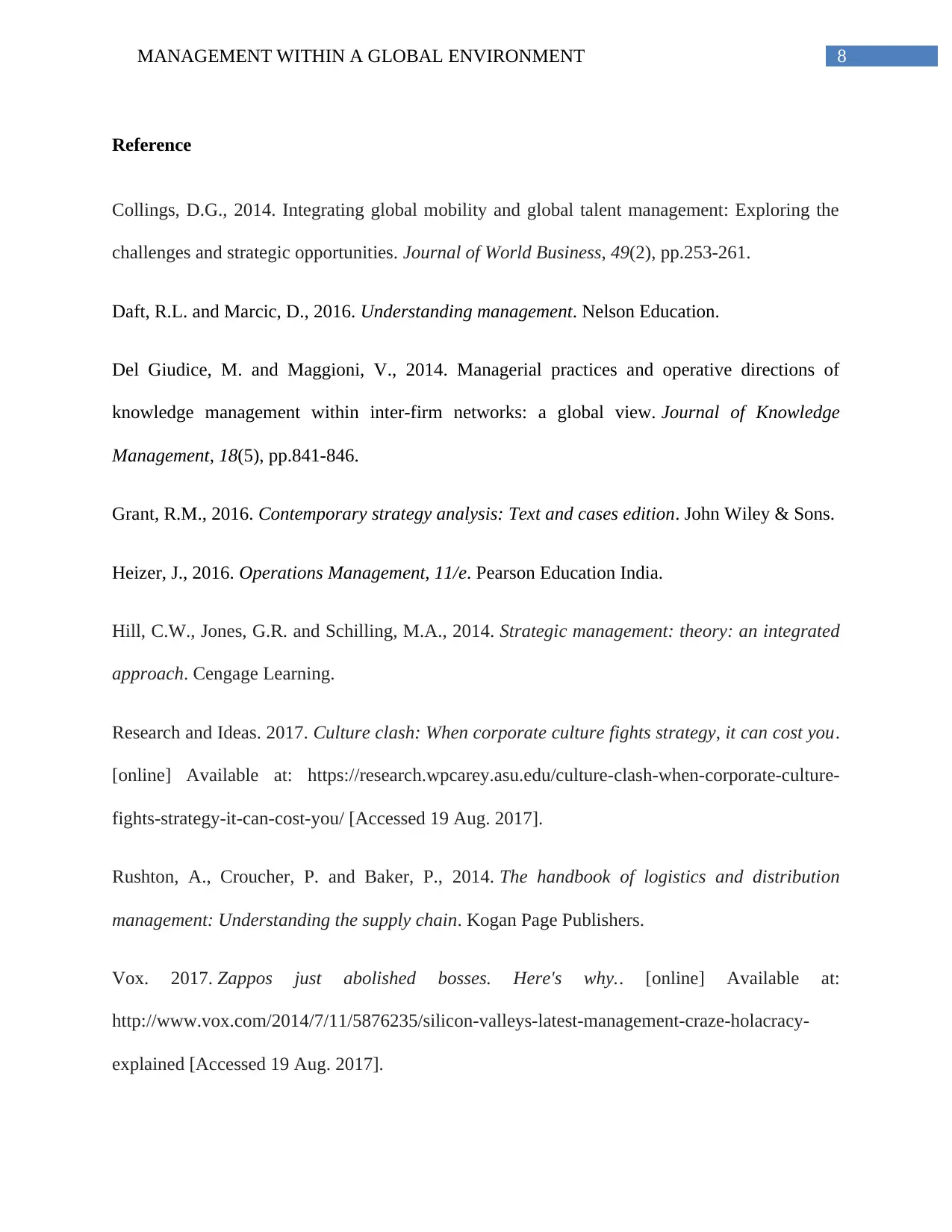
8MANAGEMENT WITHIN A GLOBAL ENVIRONMENT
Reference
Collings, D.G., 2014. Integrating global mobility and global talent management: Exploring the
challenges and strategic opportunities. Journal of World Business, 49(2), pp.253-261.
Daft, R.L. and Marcic, D., 2016. Understanding management. Nelson Education.
Del Giudice, M. and Maggioni, V., 2014. Managerial practices and operative directions of
knowledge management within inter-firm networks: a global view. Journal of Knowledge
Management, 18(5), pp.841-846.
Grant, R.M., 2016. Contemporary strategy analysis: Text and cases edition. John Wiley & Sons.
Heizer, J., 2016. Operations Management, 11/e. Pearson Education India.
Hill, C.W., Jones, G.R. and Schilling, M.A., 2014. Strategic management: theory: an integrated
approach. Cengage Learning.
Research and Ideas. 2017. Culture clash: When corporate culture fights strategy, it can cost you.
[online] Available at: https://research.wpcarey.asu.edu/culture-clash-when-corporate-culture-
fights-strategy-it-can-cost-you/ [Accessed 19 Aug. 2017].
Rushton, A., Croucher, P. and Baker, P., 2014. The handbook of logistics and distribution
management: Understanding the supply chain. Kogan Page Publishers.
Vox. 2017. Zappos just abolished bosses. Here's why.. [online] Available at:
http://www.vox.com/2014/7/11/5876235/silicon-valleys-latest-management-craze-holacracy-
explained [Accessed 19 Aug. 2017].
Reference
Collings, D.G., 2014. Integrating global mobility and global talent management: Exploring the
challenges and strategic opportunities. Journal of World Business, 49(2), pp.253-261.
Daft, R.L. and Marcic, D., 2016. Understanding management. Nelson Education.
Del Giudice, M. and Maggioni, V., 2014. Managerial practices and operative directions of
knowledge management within inter-firm networks: a global view. Journal of Knowledge
Management, 18(5), pp.841-846.
Grant, R.M., 2016. Contemporary strategy analysis: Text and cases edition. John Wiley & Sons.
Heizer, J., 2016. Operations Management, 11/e. Pearson Education India.
Hill, C.W., Jones, G.R. and Schilling, M.A., 2014. Strategic management: theory: an integrated
approach. Cengage Learning.
Research and Ideas. 2017. Culture clash: When corporate culture fights strategy, it can cost you.
[online] Available at: https://research.wpcarey.asu.edu/culture-clash-when-corporate-culture-
fights-strategy-it-can-cost-you/ [Accessed 19 Aug. 2017].
Rushton, A., Croucher, P. and Baker, P., 2014. The handbook of logistics and distribution
management: Understanding the supply chain. Kogan Page Publishers.
Vox. 2017. Zappos just abolished bosses. Here's why.. [online] Available at:
http://www.vox.com/2014/7/11/5876235/silicon-valleys-latest-management-craze-holacracy-
explained [Accessed 19 Aug. 2017].
⊘ This is a preview!⊘
Do you want full access?
Subscribe today to unlock all pages.

Trusted by 1+ million students worldwide

9MANAGEMENT WITHIN A GLOBAL ENVIRONMENT
1 out of 10
Related Documents
Your All-in-One AI-Powered Toolkit for Academic Success.
+13062052269
info@desklib.com
Available 24*7 on WhatsApp / Email
![[object Object]](/_next/static/media/star-bottom.7253800d.svg)
Unlock your academic potential
Copyright © 2020–2025 A2Z Services. All Rights Reserved. Developed and managed by ZUCOL.





